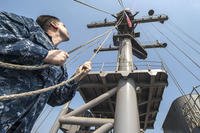PARIS -- Executives at Boeing Co. dismissed a recent audit of the P-8 Poseidon program that found the Navy needs to conduct more "critical testing" before buying production models of the submarine-hunting plane.
"I wouldn't read anything into that," Chris Raymond, vice president of business development and strategy for Boeing's Defense, Space and Security unit, said in a June 16 briefing with reporters at the company’s Paris offices before the start of the Paris Air Show. "Between us and the Navy, we still feel like we're very on track with the flight test program. It's going well."
The Pentagon next month plans to hold a meeting to decide whether to begin full production of the Boeing Co.-made aircraft — before testing is completed to determine whether it meets life-expectancy requirements, according to the summary of an audit released this week on the website of the Defense Department’s Office of Inspector General.
“Additional critical testing should be completed before the full-rate production (FRP) decision,” according to the summary dated June 10. A decision by the Pentagon’s top weapons buyer, Frank Kendall, to purchase the first 13 production models of the aircraft at an estimated cost of $2.6 billion “based on incomplete test results could result in costly retrofits to meet lifespan and mission and system performance requirements,” it states.
The author of the report wasn’t listed. The Pentagon’s inspector general position has been vacant for months. The office is headed by Principal Deputy Inspector General Lynne Halbrooks.
The overall cost to develop and build 122 of the aircraft is estimated at $34.9 billion, according to figures the Pentagon released in May.
The P-8 Poseidon made by Chicago-based Boeing is based on the company’s commercial 737–800 twin-engine narrow-body passenger jet. The naval version is designed to replace the P-3C Orion made by Bethesda, Md.-based Lockheed Martin Corp, in conducting long-range missions to hunt submarines, among other ships, and collect intelligence, according to the Navy.
Boeing is already delivering planes built under low-rate production and a training program is already in effect at Naval Air Station Jacksonville, according to Raymond.
"We're getting P-3 pilots turned into P-8 pilots," he said. "That program's very solid right now with the U.S. Navy."
The IG office recommended for Kendall to buy the aircraft under a contract for low-rate production and delay the full-rate production decision until Capt. Scott Dillon, the Navy’s program manager for maritime surveillance aircraft, demonstrates that the plane will be able to survive its 25-year lifespan without structural fatigue, overcome mission deficiencies, track surface ships and perform other primary missions.
The service may be feeling pressure to keep to the program schedule despite the challenges created by the start of automatic federal budget cuts, Raymond said.
"They're trying to fit it all in," he said. "Even production programs that are executing well, I think, we're going to have to watch over the next four, five years, [to see] how do they sort of modulate production rates as they try to fit all the budget together," he said. "I don't know that we'll totally escape from some of that, but I think that's all I would read into that."
The Defense Department faces $500 billion in automatic cuts over the next decade. That’s in addition to almost $500 billion in defense reductions already included in 2011 deficit-reduction legislation. The first installment of automatic cuts began March 1 and sliced about $37 billion from the fiscal 2013 defense budget.
The Navy hasn't indicated it plans to change its schedule and Boeing is talking to potential customers about selling more exports of the maritime patrol plane, according to Jeff Kohler, vice president of international business development at the company.
"P-8 international is picking up a lot of steam as well," he said.









